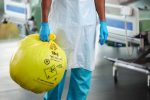What is offensive waste?
Offensive waste is a category of waste that is generated in healthcare facilities and is typically unpleasant or offensive in nature, due to odours and appearance.
Unlike other forms of healthcare waste, offensive waste is not classified as infectious or hazardous, both of which pose risk when handling, and can be found more commonly throughout hospitals and healthcare facilities. The purpose of offensive waste is to act as a middle-ground between general, municipal waste and clinical, offensive waste. This waste stream helps to avoid the contamination of general municipal waste, whilst reducing the risk of contact with infectious refuse in a clinical waste stream.
Although offensive waste does not pose the same infectious risk, it is still vital that this waste is handled carefully to avoid contamination of surroundings and environments. It is important to note that while offensive waste may not directly cause immediate threat to human health, it can contribute to unsanitary conditions and create a risk of illness if not handled properly. The most important factor of implementation of offensive waste streams are to maintain hygienic environments when disposing of offensive materials and reducing both the impact and exposure to these materials.
This waste stream can be separated into healthcare offensive waste specifically, where contents is generated in healthcare settings, for example: PPE used for patient care contaminated with non-infectious bodily fluids, as well as municipal offensive waste, which can include personal sanitary or incontinence waste. Although both are generated in healthcare spaces, hospitals must properly manage how this waste is discarded in healthcare facilities.
Offensive waste can be generated from different areas within healthcare and bins can typically be found across wards and sluices, but also in patient areas such as toilets and shower rooms. Out of all healthcare waste streams, offensive waste is the most versatile and can be used in many areas of a hospital.
Bags found in bathrooms will likely be contaminated with sanitary protection, or sanpro, waste, as well as soiled incontinence pads and nappies. Whereas offensive waste bags found on wards are likely to contain PPE used during patient care. Sluices will often be the area to dispose of used bedpans, catheters, and stoma bags, after being emptied of their contents.
What are examples of offensive waste?
Offensive waste in healthcare can refer to waste generated when taking care of patients. It can include patient interaction protection, such as aprons, gowns, gloves, and masks worn by healthcare workers, that have been soiled with bodily fluids. Offensive waste can also be generated by patients, including used bedpans, or soiled incontinence or sanitary pads.
What colour are offensive waste bags?
Offensive waste bags are yellow and black ‘tiger striped’ bags, which differ from solid yellow clinical bags. In certain hospitals and healthcare facilities, a solid yellow bag with a large, singular black stripe may be used.
Tiger striped offensive waste bags can be identified with ease and are used to visibly differentiate from yellow clinical bags. Certain tiger bags are manufactured via coextrusion of the black and yellow colours, ensuring stripes are visible on both the inside and outside of the bag. This improves identifiability of the bags. Correct implementation of tiger stripe waste bags can help to avoid placing waste into incorrect waste streams and limit gross contamination of offensive waste with infectious material. Properly segregating waste ultimately helps to reduce the cost in disposing healthcare waste.
What goes into an offensive waste bag?
| Can go into offensive waste | Cannot go into offensive waste |
|
|
|
|
|
|
How is offensive waste disposed of?
Unlike other waste streams, offensive waste in healthcare does not require the same level of disposal as clinical infectious waste. Due to there being a limited risk of infection, it does not need to be sent for incineration, reducing the costs associated with disposing offensive waste.
When properly segregated, there should not be anything that would pose risk of contact with infectious materials, meaning contents of this waste stream should be suitable to undergo alternative treatment.
Once the waste has been collected, it is transported to a licensed waste management facility for treatment and disposal. In this process, the waste is checked to ensure it does not contain anything unsuitable for treatment. Once checked, waste bags are broken down and heated at high temperatures to kill pathogens so that it can be sent to landfill. The goal of the treatment process is to render the waste safe and to reduce its environmental impact. This process reduces the amount of waste going into incineration, subsequently reducing cost of disposal.
FAQs
Are paper towels offensive waste?
Clean paper towels, including those used to dry hands after washing, can go into regular municipal waste. Any paper towels that are soiled with offensive materials should be put into offensive waste.
Are nappies offensive waste?
Soiled nappies, similar to soiled incontinence pads, can go into offensive waste streams. Clean, unused nappies should be disposed of in regular municipal waste.
Is urine considered offensive waste?
Urine still in liquid state, regardless of volume, should first be placed down a sluice. The soiled container may be placed into offensive waste. Bedpans and containers still containing urine should not be placed directly into this waste stream.
Is PPE offensive waste?
The disposal of personal protective equipment depends on the contents it is soiled with. When in contact with patients with infectious diseases, these should be put into orange or yellow clinical waste streams. If this is not the case, PPE can be placed into offensive waste.




















